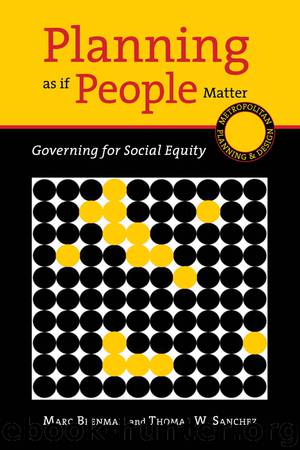Planning as if People Matter by Marc Brenman

Author:Marc Brenman
Language: eng
Format: epub
Publisher: Island Press
Published: 2012-03-06T16:00:00+00:00
TRANSPARENCY
If the information and analysis that government agencies provide to the public is to serve its purpose of enabling them to participate meaningfully in the decision-making process, transparency is an essential attribute of the information and analysis. For planning organizations, transparency refers to an open, understandable, and timely public participation process (Wolf, Sanchez, and Farquhar 2007). A continuous and accessible flow of information from public planning organizations to the public is the basis of transparency. Well-documented practices that include a wide range of internal and external communications methods are vital for stakeholders to understand processes leading to decisions. Again, trust is built when organizational activities are open to checks on accountability. Transparency occurs only with conscientious effort on the part of an organization, because additional energy is required to document and convey management and staff activities that produce planning outcomes. Transparency is diminished in the absence of accurate and continuous information, and where the information that is provided does not include the information that has been requested. Propaganda and misleading information ruin transparency. Gossip, rumor, and innuendo can damage transparency and credibility, which go hand in hand.
On the other hand, transparency can also be lost in the sheer quantity of information, as a needle can be lost in a haystack. This is a particular danger in the context of government agencies that produce reams of paper and hundreds of webpages every month. Transparency, therefore, requires that information be presented in a manner that is both concise and complete. An incomplete presentation that fails to surface important facts, assumptions, concerns, or alternatives is lacking in the integrity that the public needs in order to have its voice heard in a meaningful participation process.
Transparency is especially important with regard to community and neighborhood groups, for several reasons. These include the highly technical nature of many planning analyses, and the lack of technical expertise or support in community and neighborhood groups. There may have been bad-faith communications in the past between government agencies and communities, which means that government agencies may be starting their new relationship in a hole. This has been especially true in infrastructure decisions about transportation, education, housing, sewerage, and zoning. Transparency also implies effective communication, which is needed to build trust between governmental agencies and community groups. The consequences of a lack of transparency can be severe, and include confusion from lack of information and divisiveness, eventually leading to distrust, which can completely undermine the public participation process. Community opposition can build, leading to loss of funding, consumption of time, investment of energy by government agencies in crisis management, lawsuits, legal liability, and embarrassment.
Download
This site does not store any files on its server. We only index and link to content provided by other sites. Please contact the content providers to delete copyright contents if any and email us, we'll remove relevant links or contents immediately.
Kathy Andrews Collection by Kathy Andrews(11730)
The remains of the day by Kazuo Ishiguro(8826)
Paper Towns by Green John(5092)
Spare by Prince Harry The Duke of Sussex(5074)
Industrial Automation from Scratch: A hands-on guide to using sensors, actuators, PLCs, HMIs, and SCADA to automate industrial processes by Olushola Akande(4985)
The Body: A Guide for Occupants by Bill Bryson(4975)
Machine Learning at Scale with H2O by Gregory Keys | David Whiting(4185)
Be in a Treehouse by Pete Nelson(3951)
Never by Ken Follett(3794)
Harry Potter and the Goblet Of Fire by J.K. Rowling(3775)
Goodbye Paradise(3728)
Into Thin Air by Jon Krakauer(3313)
The Remains of the Day by Kazuo Ishiguro(3294)
The Cellar by Natasha Preston(3262)
The Genius of Japanese Carpentry by Azby Brown(3226)
Fairy Tale by Stephen King(3220)
120 Days of Sodom by Marquis de Sade(3182)
The Man Who Died Twice by Richard Osman(2997)
Drawing Shortcuts: Developing Quick Drawing Skills Using Today's Technology by Leggitt Jim(2996)
